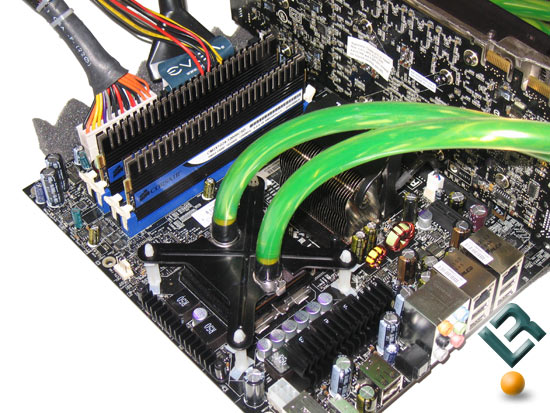Adjusting the TRC Memory Setting is Important
Testing Trc Timings

Using the Intel Core 2 Duo X6800 processor overclocked to 3.7GHz (14 x 266MHz) on the eVGA 680i SLI motherboard (P23 BIOS) we were able to get the Corsair PC2-10000C5 memory running at 1244MHz at 5-5-5-15 2T timings with just 2.1V on the memory. A PC Power & Cooling 1000W power supply made sure everything had enough power and the XFX 8800GTX graphics card and Western Digital 250GB SATA hard drive rounded up the test system. To keep things simple we changed just one setting in the BIOS and that was the Trc.
Bandwidth Testing:
To start out testing the impact of adjusting the Trc we ran Everest Ultimate, Sandra 2007, Sciencemark 2.0 and Super Pi each five times and took the average of each test to get the results below.
|
Benchmark:
|
Everest Ultimate
|
Sandra 2007
|
Sciencemark
|
Super Pi
|
|||
| Test: |
Read
|
Write
|
Copy
|
Latency
|
Buffered
|
Bandwidth
|
4M Block
|
| Trc 35 |
7575
|
5678
|
5964
|
50.1
|
6249
|
5796.12
|
82.78 secs
|
| Trc 15 |
7598
|
5679
|
6050
|
50.1
|
6344
|
5873.20
|
79.59 secs
|
It’s obvious that by lowering the Trc from 35 to 15 we were able to notice a recordable difference in performance. In Everest slight gains were noticed in the Read and Copy tests. Both Sandra and Sciencemark showed a bandwidth gain of 100MB/Sec, which is awesome for changing just one setting. In Super Pi we were amazed that we were able to reduce the time it took to complete by over three seconds! Of all the results here the most shocking is by far improvement seen in Super Pi.
Game Testing:
When it comes to gaming Comanche 4, Quake 4 v1.3 and F.E.A.R. v1.08 were run five times at a resolution of 1024×768 with the averages taken and shown below. Both Quake 4 and F.E.A.R. had 4x AA and 8x AF enabled.
| Benchmark: | Comanche 4 | Quake 4 | F.E.A.R. |
| Trc 35 |
142.51 |
121.1 |
149 |
| Trc 15 |
142.88 |
123.2 |
154 |
It’s clear that reducing the Row Cycle Time (Trc) helped improve the frame rate for all of the games, but not enough to be significant (equal to or greater than 5%) in any of them. The biggest difference was noted in F.E.A.R. where a five frame per second difference was noticed between the two Trc settings. While the differences are minor we were able to improve system performance by ~1-4% on all seven of the applications used to test out the Trc setting change. It’s clear that to get the most performance out of your system advanced memory need to be set on systems that allow it.

Comments are closed.